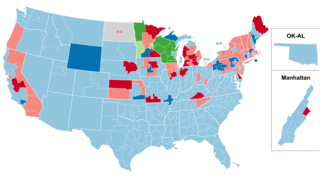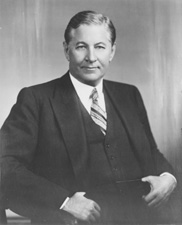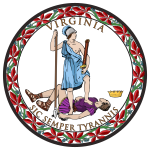
The 1934 United States Senate elections were held in the middle of Democratic President Franklin D. Roosevelt's first term. The 32 seats of Class 1 were contested in regular elections, and special elections were held to fill vacancies. During the Great Depression, voters strongly backed Roosevelt's New Deal and his allies in the Senate, with Democrats picking up a net of nine seats, giving them a supermajority. Republicans later lost three more seats due to mid-term vacancies ; however, a Democrat in Iowa died and the seat remained vacant until the next election. The Democrats entered the next election with a 70-22-2-1 majority.

The 1934 United States House of Representatives elections were elections for the United States House of Representatives to elect members to serve in the 74th United States Congress. They were held for the most part on November 6, 1934, while Maine held theirs on September 10. They occurred in the middle of President Franklin D. Roosevelt's first term. The Democratic Party continued its progress, gaining another 9 net seats from the opposition Republican Party, who also lost seats to the Progressive Party. The Republicans were reduced below one-fourth of the chamber for the first time since the creation of the party. The Wisconsin Progressive Party, a liberal group which allied with the Democrats, also became a force in Wisconsin politics.

The 1934 California gubernatorial election was held on November 6, 1934. Held in the midst of the Great Depression, the 1934 election was amongst the most controversial in the state's political history, pitting conservative Republican Frank Merriam against former Socialist Party member turned Democratic politician Upton Sinclair, author of The Jungle. A strong third party challenge came from Progressive Raymond L. Haight, a Los Angeles lawyer campaigning for the political center. Much of the campaign's emphasis was directed at Sinclair's EPIC movement, proposing interventionist reforms to cure the state's ailing economy. Merriam, who had recently assumed the governorship following the death of James Rolph, characterized Sinclair's proposal as a step towards communism.

The 1934 United States elections were held on November 6, 1934. The election took place in the middle of Democratic President Franklin D. Roosevelt's first term, during the Great Depression. In a historic midterm election, the Democrats built on the majorities in both houses of Congress they had won in the previous two elections.

The 1934 Pennsylvania gubernatorial election occurred on November 6, 1934. Incumbent Republican governor Gifford Pinchot was not a candidate for re-election.

The 1940 United States Senate election in Missouri was held on November 5, 1940. Incumbent Democratic U.S. Senator and future President of the United States Harry S. Truman, who was first elected in 1934, decided to seek re-election to a second term. He narrowly survived a primary challenge from Governor of Missouri Lloyd C. Stark before also narrowly defeating Republican nominee Manvel H. Davis in the general election.

The 1934 United States Senate special election in Montana took place on November 6, 1934. Incumbent United States Senator John E. Erickson, who, as governor, had appointed himself to the seat in 1933 upon the death of Thomas J. Walsh, ran for re-election. However, he was defeated in the Democratic primary by James E. Murray, who was the former Silver Bow County Attorney and the Chairman of the State Advisory Board of the Public Works Administration. In the general election, Murray defeated Scott Leavitt, a former United States Congressman who had represented Montana's 2nd congressional district, and an independent candidate in a landslide to win his first term in the Senate.

The 1934 United States Senate election in Montana took place on November 6, 1934. Incumbent United States Senator Burton K. Wheeler, who was first elected to the Senate in 1922, and was re-elected in 1928, ran for re-election. After easily winning the Democratic primary, Wheeler moved on to the general election, where he faced George M. Bourquin, a former United States Federal Judge and the Republican nominee. In a stark contrast to his close campaign in 1928, Wheeler won re-election to his third Senate term in a landslide.
Elections to Liverpool City Council were held on 1 November 1934. One third of the council seats were up for election, the term of office of each councillor being three years.
Elections to Liverpool City Council were held on 1 November 1933. One third of the council seats were up for election, the term of office of each councillor being three years.

The 1934 United States Senate election in New York was held on November 6, 1934, to elect a U.S. Senator. Incumbent Democratic Senator Royal Copeland was re-elected to a third term in office, though he would die in office in 1938.

The 1934 Arizona gubernatorial election took place on November 6, 1934. Incumbent Governor Benjamin Baker Moeur ran for reelection, he was challenged by former governor George W. P. Hunt and future Governor Rawghlie Clement Stanford in the Democratic primary, but he defeated both of them by a comfortable margin.

The 1934 United States Senate election in Florida was held on November 6, 1934.

The 1934 United States Senate election in California was held on November 6, 1934. Incumbent Republican Senator Hiram Johnson was re-elected to his fourth term in office.

The 1934 United States Senate election in Wisconsin was held on November 6, 1934.

The 1934 Wyoming gubernatorial election took place on November 6, 1934. Incumbent Democratic Governor Leslie A. Miller ran for re-election to his second term, and his first full term, following his initial election in the 1932 special election. Miller faced Republican Alonzo M. Clark, his predecessor as governor, in the general election. Despite the closeness of Miller's first election, he took advantage of the nationwide Democratic landslide and easily defeated Clark.

The 1934 Massachusetts gubernatorial election was held on November 6, 1934.

The 1934 Tennessee gubernatorial election was held on November 6, 1934. Incumbent Democratic Governor Hill McAlister won re-election to a second term, defeating Independent nominee Lewis S. Pope in a rematch with 61.8% of the vote.

The 1934 Wisconsin gubernatorial election was held on November 6, 1934. Primary elections were held on September 18, 1934. Incumbent Democratic Governor Albert G. Schmedeman was defeated by Progressive nominee Philip La Follette. As of 2022, this is the last time Green Lake County voted for the Democratic nominee for governor and the last time that Waushara County did not vote for the Republican candidate.

The 1934 United States Senate elections in Wyoming took place on November 6, 1934. Incumbent Democratic Senator John B. Kendrick died on November 3, 1933, and Joseph C. O'Mahoney was appointed by Governor Leslie A. Miller as Kendrick's replacement. Two elections for the same Senate seat were held on the same day; one as a special election to fill the remainder of Kendrick's original six-year term, and another to select a Senator to serve the next six-year term. O'Mahoney ran for re-election in both elections. He was opposed by Republican Congressman Vincent Carter. Aided by the strong performance by the Democratic Party throughout the country in 1934, and by Governor Miller's landslide re-election, O'Mahoney handily defeated Carter to win re-election.




















